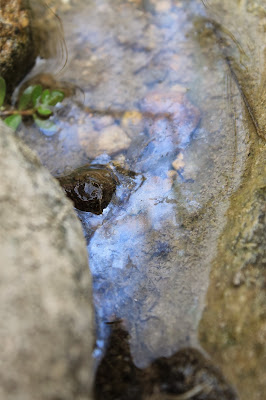Crystallofolia.
The plant Frostweed (Verbesina virginica) goes by other names such as “frost-plant,” “iceplant,” and “frostwort.”
I first saw frost extruding from our lantanas up by the house. Immediately, I hurried down to the south end of the Pond where it empties into the Creek, knowing that if anywhere there might be frostweed “blooming,” it would be there. And yes, thin curls of frostweed sap had split open the epidermis of stems during the week's cold snap of low twenty-degree temperatures.
This tall (over six feet, commonly) early-autumn blooming weed produces nice bunches of white flowers in its corymb. But the phenomenon of its “frost flowers” are most remarkable. Some people call them “rabbit ice” or “ice flowers.” German botanists two centuries ago called them “Eisblatt” (“ice leaf”).
Exactly what benefit is conferred upon the plant itself when it cracks open on a cold, late-autumn night is still somewhat unclear. Some botanists have suggested that the process allows for self-pruning, theoretically an advantage for the emerging new plant from the root-base the following spring. Not sure if there is any solid basis for this explanation, though. What I don’t question is my own experience of excitement and awe each year that I am lucky enough to see and touch the thin croissant-layers of frozen plant-blood.
Two weeks ago, the iridescence formed by one of the world's thousands of mineral-utilizing bacteria could be seen in the quiet pieces of still puddle-water along side the creek. These may be the same iron-oxidizing bacteria that inhabit our well. Generally we'll see these rainbow-colored films after a period of warmer weather and always in still water where there's little dissolved oxygen. They resemble oil-slicks but can be easily differentiated from those if we poke the center of the film with a stick and the hole in the film does not quickly close back up.
The plant Frostweed (Verbesina virginica) goes by other names such as “frost-plant,” “iceplant,” and “frostwort.”
I first saw frost extruding from our lantanas up by the house. Immediately, I hurried down to the south end of the Pond where it empties into the Creek, knowing that if anywhere there might be frostweed “blooming,” it would be there. And yes, thin curls of frostweed sap had split open the epidermis of stems during the week's cold snap of low twenty-degree temperatures.
This tall (over six feet, commonly) early-autumn blooming weed produces nice bunches of white flowers in its corymb. But the phenomenon of its “frost flowers” are most remarkable. Some people call them “rabbit ice” or “ice flowers.” German botanists two centuries ago called them “Eisblatt” (“ice leaf”).
Exactly what benefit is conferred upon the plant itself when it cracks open on a cold, late-autumn night is still somewhat unclear. Some botanists have suggested that the process allows for self-pruning, theoretically an advantage for the emerging new plant from the root-base the following spring. Not sure if there is any solid basis for this explanation, though. What I don’t question is my own experience of excitement and awe each year that I am lucky enough to see and touch the thin croissant-layers of frozen plant-blood.
I love to see bacteria. They deserve our respect. I don't know of any other life around here that's been on Earth so long: about three billion years ago, long before plants eventually took to cooking energy from the sun's light, these ancient bacteria figured out how to use minerals, instead.
These cold, evening currents bear, perhaps, the barest microscopic remains of two poor citizens of our county who were found dead in the creek several miles upstream from here four mornings ago. Just before dawn, the couple's pickup went off a low bridge for reason only the screech owls and coyotes might guess. The man and woman were found dead in the water.










No comments:
Post a Comment